Long-Term Variation Patterns of Precipitations Driven by Climate Change in China from 1901 to 2022
Abstract
:1. Introduction
2. Materials and Methods
2.1. Study Area
2.2. Data Source and Preprocessing
2.3. Research Methods
2.3.1. Technical Flowchart
2.3.2. Mann–Kendall Trend Test
2.3.3. Mann–Kendall Mutation Test
2.3.4. Center of Gravity Model
2.3.5. Validation of WorldClim Data
3. Results
3.1. Spatial Distribution of Precipitation during 1901–2022
3.2. Temporal Variations in Precipitation during 1901–2022
3.3. Distribution Characteristics of the Centers of Gravity in Different Basins
4. Discussion
5. Conclusions
Author Contributions
Funding
Institutional Review Board Statement
Informed Consent Statement
Data Availability Statement
Conflicts of Interest
References
- Yao, H.X.; Li, Q.Q.; Zhao, L.; Wu, X.Q.; Shen, X.Y.; Duan, C.F.; Li, C. Evolution characteristics of compound drought and heat events during the warm season in the Huaihe River Basin and their relationship with climate and vegetation. Acta Ecol. Sin. 2024, 44, 5596–5608. [Google Scholar]
- Zhao, Z.C.; Luo, Y.; Huang, J.B. Global climate indicators, climatic-impact drivers and global warming. Clim. Chang. Res. 2024, 20, 384–388. [Google Scholar]
- Liang, P.D.; Liu, A.X.; Duan, L.Y.; Zhou, M.S.; Zhou, L.D. The Relationship between the Persistent Anomaly of Spring and Summer Atmospheric Circulation in the Middle Part of Asia and the Summer Drought/Waterlogging in Eastern China. Chin. J. Atmos. Sci. 2008, 32, 1174–1186. [Google Scholar]
- Xu, D.P.; Li, J.M.; Zhou, Z.H.; Liu, J.J.; Yan, Z.Q.; Wang, D.X. Study on the spatial and temporal distribution of precipitation characteristics in China from 1956 to 2018. Water Resour. Hydropower Eng. 2020, 51, 20–27. [Google Scholar]
- Chen, S.; Zhao, W.W.; Han, Y. Spatio-temporal variation of vegetation precipitation use efficiency and influencing factors in arid and semi-arid areas of China. Acta Ecol. Sin. 2023, 43, 10295–10307. [Google Scholar]
- Yang, Z.H.; Tuo, Y.; Yang, J.; Wu, Y.Z.; Gong, Z.Q.; Feng, G.L. Integrated prediction of summer in China based on multi dynamic-statistic methods. Chin. J. Geophys. 2024, 67, 982–996. [Google Scholar]
- Liu, X.P.; Tong, X.H.; Jia, Q.Y.; Xin, Z.H.; Yang, J.R. Precipitation concentration characteristics in China during 1960–2017. Adv. Water Sci. 2021, 32, 10–19. [Google Scholar]
- Wang, L.P.; Wang, Y.Z.; Xiang, X.; Sun, H.; Lian, Z.H. Research on classification of short-duration heavy rain based on Gumbel-Linear Moment and K-Means algorithm. Chin. J. Geophys. 2023, 66, 3171–3184. [Google Scholar]
- Hu, Y.Y.; Xiao, Y.; Dai, S.P.; Luo, H.X.; Li, Y.P.; Li, M.F. Spatio-temporal Variation Characteristics of Precipitation and Temperature in Tropical China from 1961 to 2015. Southwest China J. Agric. Sci. 2021, 34, 1788–1795. [Google Scholar]
- Lu, S.; Hu, Z.Y.; Wang, B.P.; Qin, P.; Wang, L. Spatio-temporal Patterns of Extreme Precipitation Events over China in Recent 56 Years. Plateau Meteorol. 2020, 39, 683–693. [Google Scholar]
- Deng, H.J.; Guo, B.; Cao, Y.Q.; Chen, Z.S.; Zhang, Y.Q.; Chen, X.W.; Gao, L.; Chen, Y.; Liu, M.B. Spatial and temporal patterns of daytime and nighttime precipitation in China during 1961–2016. Geogr. Res. 2020, 39, 2415–2426. [Google Scholar]
- Zhao, Z.H.; Luo, Z.J.; Huang, L.X.; Xing, L.T.; Sun, H.J.; Chen, H.L.; Sun, B. Analysis of Precipitation and Groundwater Variation Based on STL and Mann-Kendall Methods in Jinan City. J. China Hydrol. 2022, 42, 73–77. [Google Scholar]
- Oliver, J.E. Monthly precipitation distribution: A comparative index. Prof. Geogr. 1980, 32, 300–309. [Google Scholar] [CrossRef]
- Michiels, P.; Gabriels, D.; Hartmann, R. Using the seasonal and temporal Precipitation concentration index for characterizing the monthly rainfall distribution in Spain. Catena 1992, 19, 43–58. [Google Scholar] [CrossRef]
- Javier, M. Spatial distribution of a daily precipitation concentration index in peninsular Spain. Int. J. Climatol. 2004, 24, 959–971. [Google Scholar]
- Kong, F.; Shi, P.J.; Fang, J.; Lu, L.L.; Fang, J.Y.; Guo, J.P. Advances and Prospects of Spatiotemporal Pattern Variation of Extreme Precipitation and its Affecting Factors under the Background of Global Climate Change. J. Catastrophol. 2017, 32, 165–174. [Google Scholar]
- Liu, K.; Nie, G.G.; Zhang, S. Study on the spatiotemporal evolution of temperature and precipitation in China from 1951 to 2018. Adv. Earth Sci. 2020, 35, 1113–1126. [Google Scholar]
- He, Q.X.; Chen, C.F.; Wang, Y.H.; Sun, Y.N.; Liu, Y.T.; Hu, B.J. Fusion Method for Multi-Source Remote Sensing Daily Precipitation Data: Random Forest Model Considering Spatial Autocorrelation. J. Geo-Inf. Sci. 2024, 26, 1517–1530. [Google Scholar]
- Zhang, R.N.; Sun, C.H.; Li, W.J. Relationship between the interannual variations of Arctic sea ice and summer Eurasian teleconnection and associated on summer precipitation over China. Chin. J. Geophys. 2018, 61, 91–105. [Google Scholar]
- Zhang, L.J.; Qian, Y.F. Annual distribution features of precipitation in China and their interannual variations. Acta Meteorol. Sin. 2003, 17, 146–163. [Google Scholar]
- Peng, S.Z. 1-km monthly precipitation dataset for China (1901–2023). Natl. Tibet. Plateau/Third Pole Environ. Data Cent. 2020, 12, 15–24. [Google Scholar]
- Zhang, D. Study on the Characteristics of Nighttime Light Distribution and Urban Gravity Center Migration in Urumqi. J. Xinjiang Norm. Univ. 2021, 40, 29–34+51. [Google Scholar]
- Yan, J.; Li, H.; Wang, J.N. Prediction of the Spatio-Temporal Variation Characteristics of Precipitation in Central Asia Based on the CMIP6 Model. Sci. Technol. Inf. 2024, 22, 244–248. [Google Scholar]
- Gao, X.T.; Dong, J.; Yang, R.R. Temporal and Spatial Variation of Precipitation in North China During the Last 50 Years. Henan Sci. 2016, 34, 596–600. [Google Scholar]
- Liu, M.R.; Liu, S.T.; Ma, C.Y.; Li, H.; Chang, S.H.; Hou, F.J.; Liu, Y.J. Research progress of the responses of grassland plants and soil to the variation of temperature and precipitation. Chin. J. Ecol. 2023, 8, 125–137. [Google Scholar]
- Zhang, X.; Li, P.; Li, D. Spatiotemporal variations of precipitation in the southern part of the Heihe river basin (China), 1984–2014. Water 2018, 10, 410. [Google Scholar] [CrossRef]
- Lv, J.X.; Liu, C.M.; Liang, K.; Tian, W.; Bai, P.; Zhang, Y.H. Spatiotemporal variations of extreme precipitation in the Yellow River Basin based on water resources regionalization. Resour. Sci. 2022, 44, 261–273. [Google Scholar] [CrossRef]
- Wang, L.Z.; Miao, J.F.; Han, F.R. Overview of Impact of Topography on Precipitation in China over Last 10 Years. Meteorol. Sci. Technol. 2018, 46, 64–75. [Google Scholar]
- Du, Y.B.; Li, S.S.; Feng, D.; Xiao, Y.Q.; Chen, X.T.; Huang, S.N.; Du, L.L. Characteristics of Extreme Summer Precipitation and Large-Scale Cir-culation in Shaanxi Province under Global Warming. Plateau Meteorol. 2024, 43, 342–352. [Google Scholar]
- Wang, Q.F.; Chen, M.; Qi, X.H. Analysis of Multi-Year Precipitation and Evaporation Changes in Fujin City from 1992 to 2020. Water Resour. Dev. Manag. 2024, 10, 70–73+69. [Google Scholar]
- Zhang, Y.Y.; Xin, C.L.; Guo, X.Y.; Zhang, B.; Chen, N.; Shi, Y.F. Characteristics of Stable Isotopes in Precipitation and Its Moisture Sources in the Inland Regions of Northwest China. Environ. Sci. 2024, 45, 2080–2095. [Google Scholar]
- Lang, L.C.; Tang, C.; Gao, X.; Li, Z.H.; Wu, F. Spatial interpolation of high-resolution daily precipitation over complex terrains. Acta Geogr. Sin. 2023, 78, 101–120. [Google Scholar]
- Tang, W.R.; Fang, K.Y.; Mei, Z.P.; Wu, H.; Zhou, F.F.; Chen, Y.; Li, W.L. The influence of climate change on social evolution in Eurasia over the past millennium. Chin. Sci. Bull. 2024, 1–12. [Google Scholar]
- Li, X.E.; Liu, Y.; Jiang, L.M.; Huang, R.G.; Zhou, Z.W.; Pang, X.G. A Review on Remote Sensing Monitoring of Glacial Lake Change and Glacial Lake Outburst Floods in Mountain Glacier Regions. J. Geo-Inf. Sci. 2024, 26, 1019–1039. [Google Scholar]
- Zhang, Y.R.; Zhou, D.G.; Guo, X.F. Regional climate response to global warming in the source region of the Yellow River and its impact on runoff. Sci. China Earth Sci. 2024, 54, 862–873. [Google Scholar] [CrossRef]
- Liu, J.X.; Zhu, Z.W.; Lu, R.; Li, J. Objective Classification of Sea Surface Temperature Evolution diversity of ENSO Cycle. Plateau Meteorol. 2024, 4, 87–102. [Google Scholar]
- Yang, B.L. Analysis of Runoff Change Characteristics and Driving Factors in the Upper Reaches of the Meijiang River Basin. Guangdong Water Resour. Hydropower 2022, 7, 43–47. [Google Scholar]
- Chen, L.J.; Wang, Y.Y.; Li, W.J.; Sun, L.H.; Li, X.; Zhang, D.Q. Review of the Influence and Application of SST Anomaly to Flood Season Precipitation in China. J. Appl. Meteorol. Sci. 2024, 35, 129–141. [Google Scholar]
- Hao, Z.C.; Chen, Y. Research progresses and prospects of multi-sphere compound extremes from the Earth System perspective. Sci. China Earth Sci. 2024, 67, 343–374. [Google Scholar] [CrossRef]
- Wang, J.W.; Ran, J.L.; Wu, W.; Shang, R.Y.; Zhang, Z.M.; Zhang, M.X.; Liu, J.K. Scaling Effects of Anthropogenic and Climate Change Impacts on Runoff in the Haihe River Basin. J. Ecol. Rural. Environ. 2024, 40, 757–765. [Google Scholar]
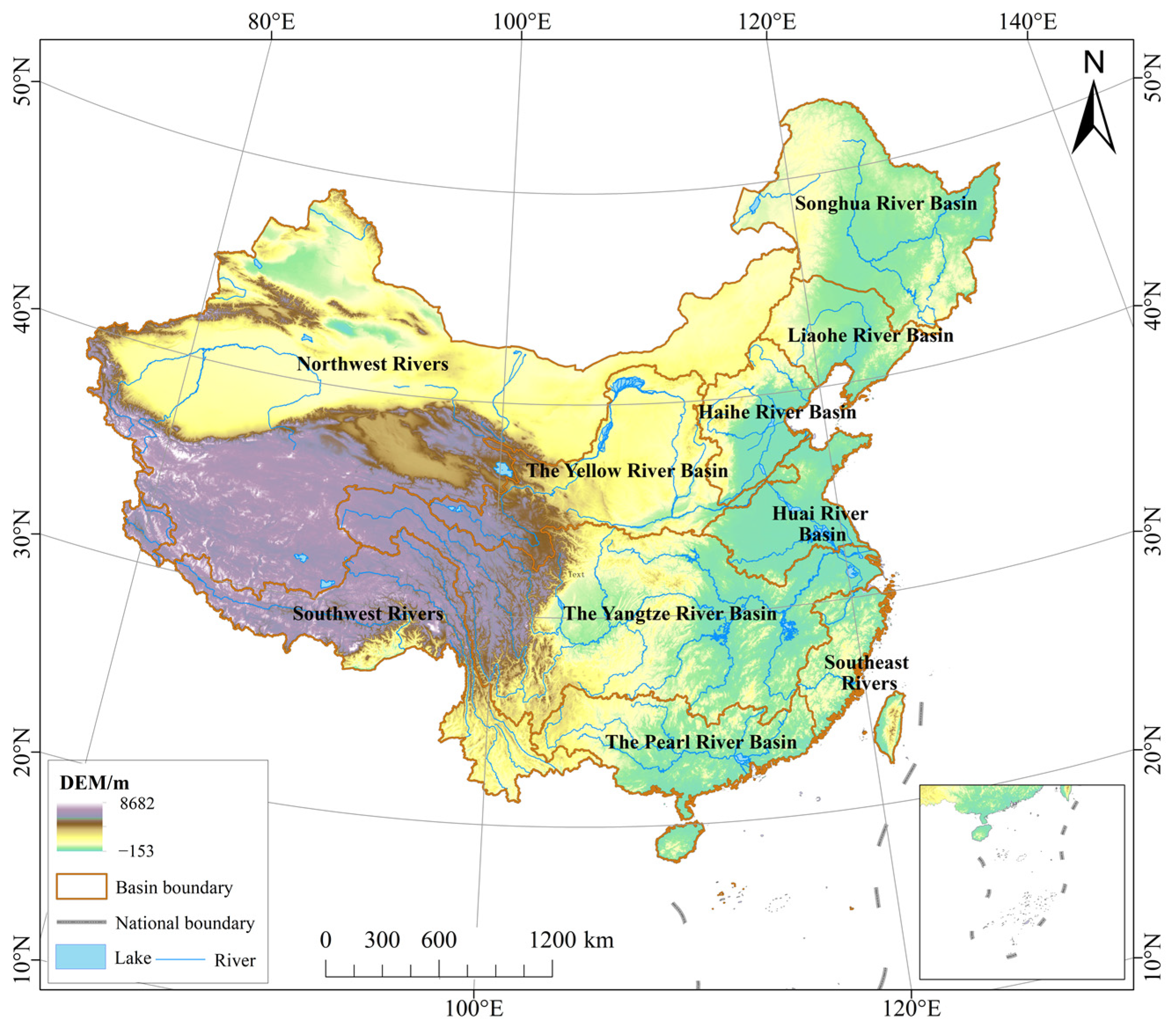
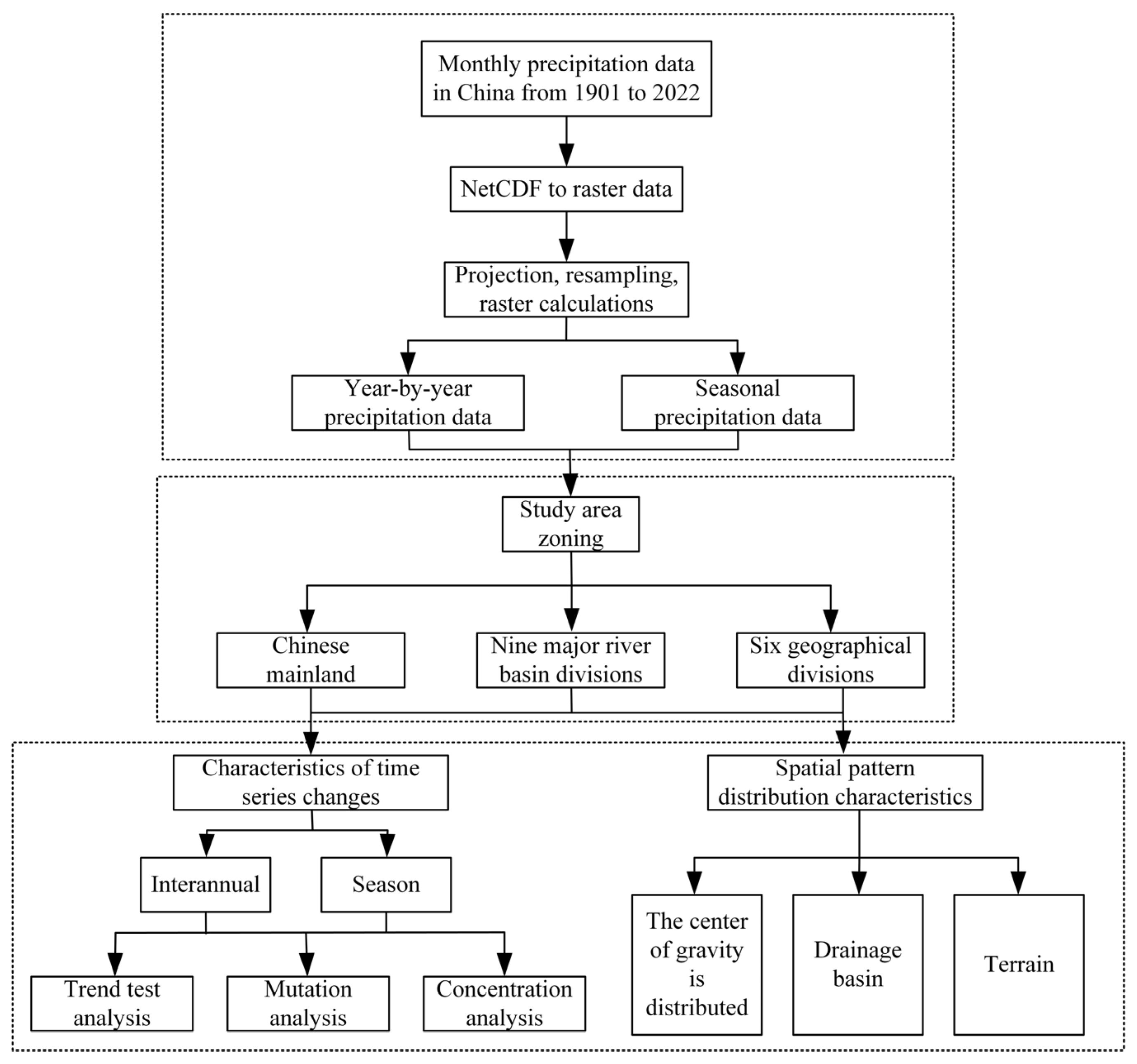
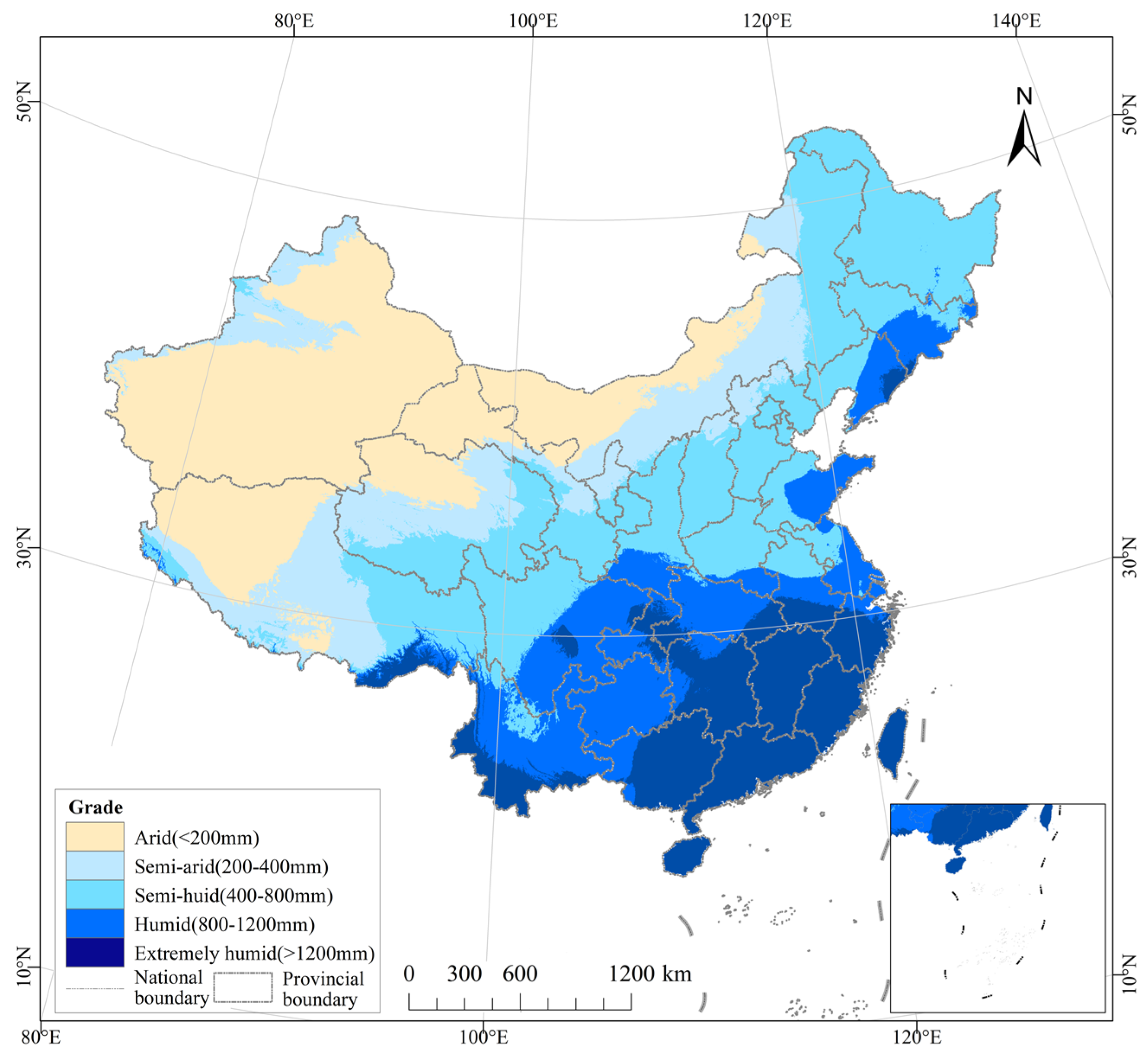

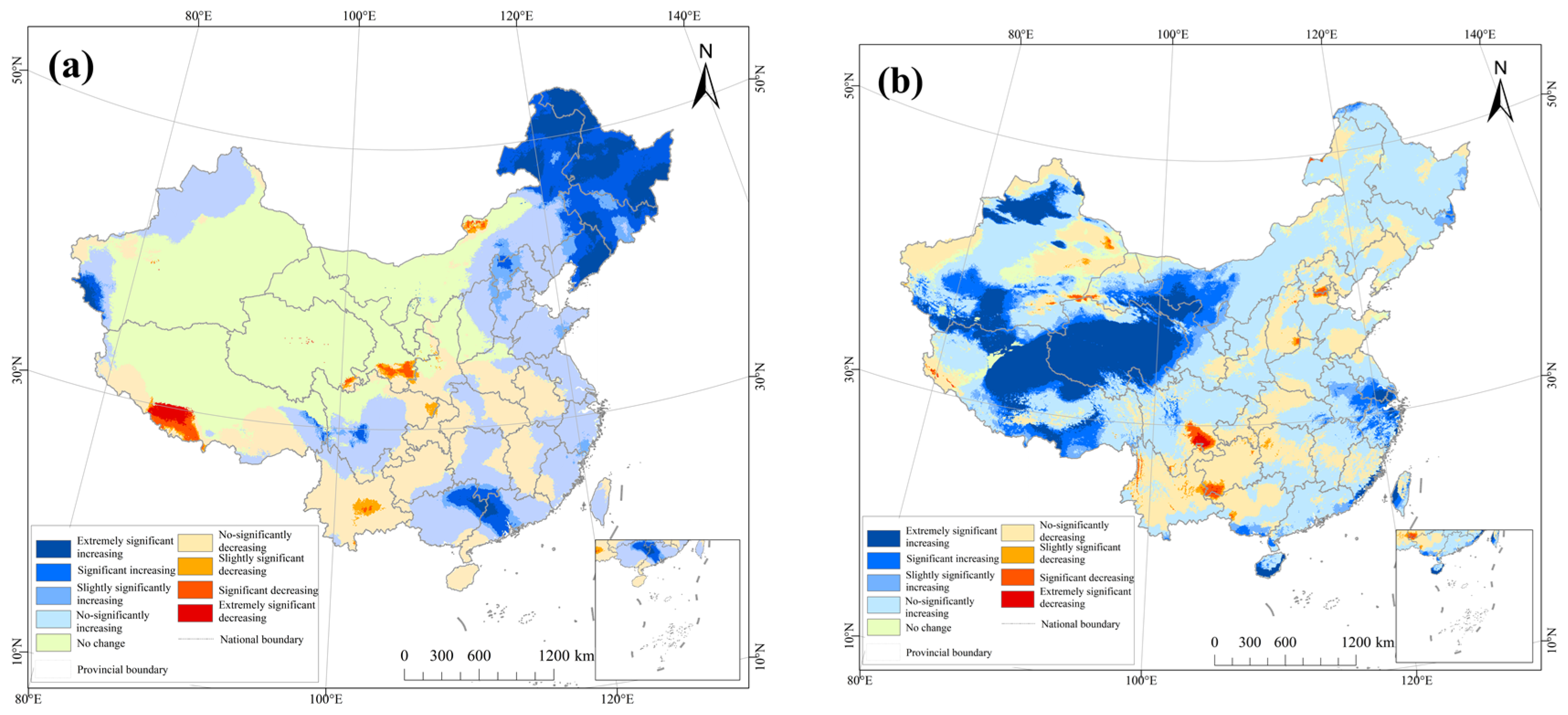
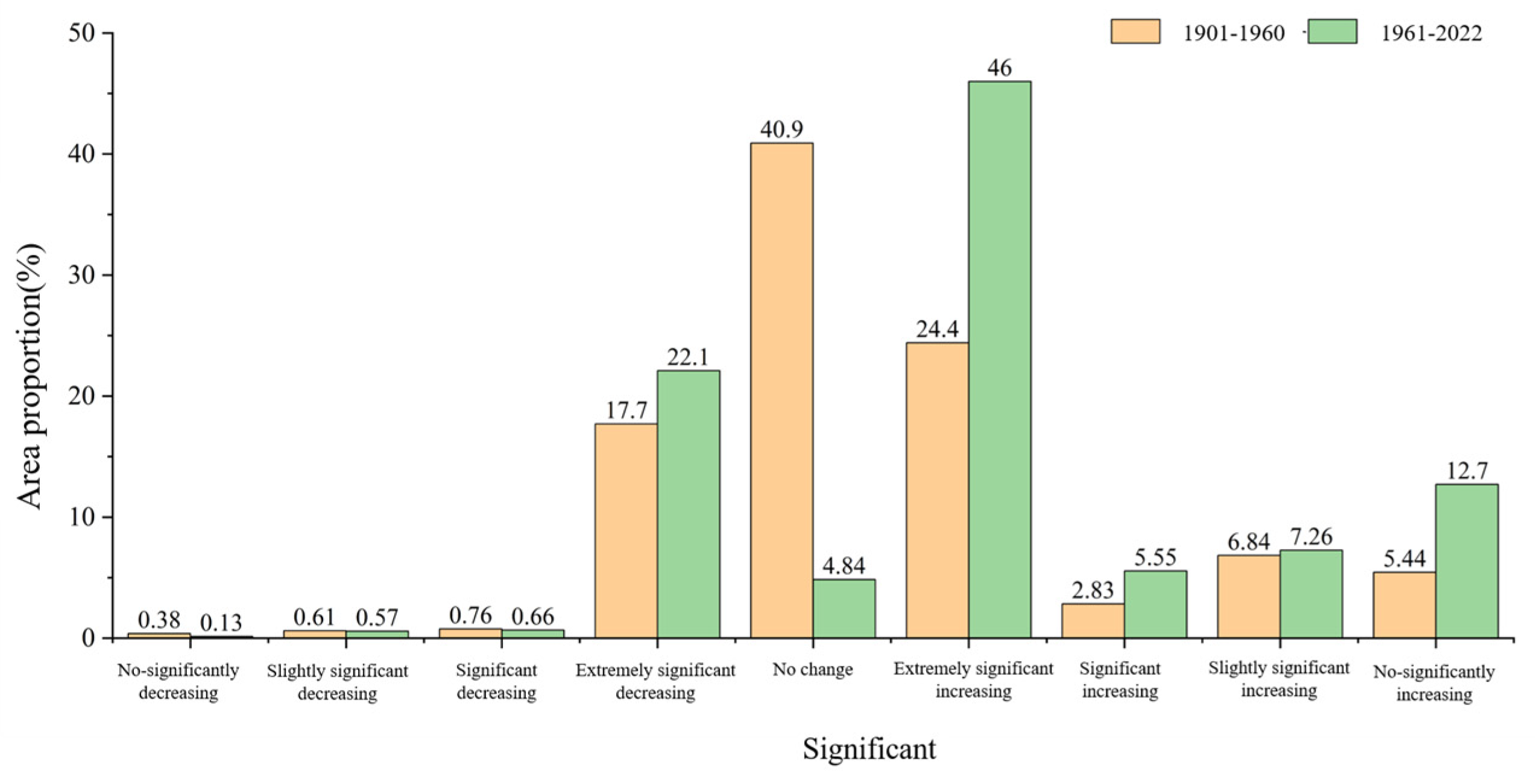





| Standard Deviation Ellipse Parameter | Corner Angle (°) | Standard Deviation along the x-Axis (km) | Standard Deviation along the y-Axis (km) | Area (km2) |
|---|---|---|---|---|
| Yangtze River basin | 86.536 | 14.003 | 4.993 | 219.653 |
| Southeast rivers | 159.135 | 1.936 | 5.076 | 30.868 |
| Haihe River basin | 28.621 | 2.626 | 6.989 | 57.649 |
| Huaihe River basin | 27.766 | 1.997 | 8.562 | 53.712 |
| Yellow River basin | 73.629 | 14.555 | 2.072 | 94.766 |
| Liaohe River basin | 108.775 | 6.725 | 2.533 | 53.520 |
| Songhua River basin | 136.282 | 3.586 | 8.622 | 97.122 |
| Northwest rivers | 77.143 | 28.818 | 15.139 | 1370.655 |
| Southwest rivers | 126.563 | 11.551 | 3.268 | 118.604 |
| Pearl River basin | 101.161 | 9.823 | 3.962 | 122.268 |
Disclaimer/Publisher’s Note: The statements, opinions and data contained in all publications are solely those of the individual author(s) and contributor(s) and not of MDPI and/or the editor(s). MDPI and/or the editor(s) disclaim responsibility for any injury to people or property resulting from any ideas, methods, instructions or products referred to in the content. |
© 2024 by the authors. Licensee MDPI, Basel, Switzerland. This article is an open access article distributed under the terms and conditions of the Creative Commons Attribution (CC BY) license (https://creativecommons.org/licenses/by/4.0/).
Share and Cite
Han, J.; Zhang, R.; Guo, B.; Han, B.; Xu, T.; Guo, Q. Long-Term Variation Patterns of Precipitations Driven by Climate Change in China from 1901 to 2022. Sustainability 2024, 16, 7283. https://doi.org/10.3390/su16177283
Han J, Zhang R, Guo B, Han B, Xu T, Guo Q. Long-Term Variation Patterns of Precipitations Driven by Climate Change in China from 1901 to 2022. Sustainability. 2024; 16(17):7283. https://doi.org/10.3390/su16177283
Chicago/Turabian StyleHan, Jing, Rui Zhang, Bing Guo, Baomin Han, Tianhe Xu, and Qiang Guo. 2024. "Long-Term Variation Patterns of Precipitations Driven by Climate Change in China from 1901 to 2022" Sustainability 16, no. 17: 7283. https://doi.org/10.3390/su16177283






